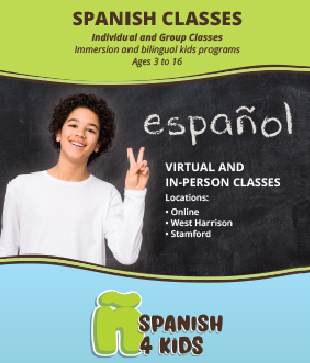We wanted to facilitate communication between our children and our relatives. We also wanted our kids speaking a second language to use professionally. However, something happened on the way! Our plans failed and we did not reach our desired results. What happened?
Since the birth of our children, two languages have always been spoken in our home. As parents, we are two different nationalities speaking two different languages. Our goal was to speak to the children in our native languages so that they would grow up immersed in two languages. However, the result was a bilingual communication. We are speaking in our native language, but the kids are responding in English. They clearly understand us. Why can’t they just respond in our languages? We know that our case is not isolated. Many parents seem to have experienced this same situation.
What were we doing wrong?
Maybe we didn’t take into consideration some important tools that could have helped our children in their learning process.
Our children understand a second language but refuse to speak it! How did we get here?
There is not just one simple answer to this question. Sometimes external factors such as learning or emotional problems are at play. Nevertheless, the factor we want to primarily address is not expecting a response from children in the language they are learning. As a consequence, a type of communication exchange is created where the use of two languages in the same conversation is normal.
What leads us to not expecting answers in the language that is being learned?
We know that speaking a second language takes more time. Therefore, a lack of patience, distractions in the moment, or a belief that they do not understand us can lead to accepting responses in English.
Here are some suggestions to make learning a second language a pleasant and effective process:
• Speak in your native language and pay attention to get the answer in that same language. If your child does not answer in this language, he or she may not feel safe or comfortable. In that case, give the answer and ask them to repeat it. In this way, you will be giving them the confidence they need to express themselves. At first, this can be overwhelming for both parties, but don’t be discouraged. This is the key to success.
• Focus on specific phrases and reinforce them regularly until you see them become routine. For example: one week you can work with the phrases “I like …” or “I do not like …” accompanying them with food, clothing, and sports. Another week you can focus on “I need …” or “I do not need …”
• When a kid spends time watching television, make sure it is in the language they are learning. Netflix offers the option to choose a preferred language from the account settings.
• If you have the opportunity, allow your children to participate in get togethers with friends where all speak the second language. This can facilitate practice in a comfortable setting.
• Other useful activities include attending events in other languages and participating in group or private language classes.
REMEMBER
Your children are not bilingual just because they understand what they are hearing. They must also be able to speak the second language.
Desde el nacimiento de nuestros hijos, en nuestro hogar siempre se habló dos idiomas. Somos padres de dos nacionalidades distintas y hablamos idiomas distintos. Nuestra meta fue hablarles a nuestros hijos en nuestra lengua natal de modo que ellos crecieran inmersos en dos idiomas. Pero el resultado fue comunicaciones bilingües. Nosotros hablando en nuestra lengua natal y ellos respondiendo en inglés. ¿Entender, nos entienden? ¿Por qué simplemente no pueden hablarlo? También sabemos que nuestro caso no es aislado. Muchos padres parecen experimentar la misma situación.
¿Qué hemos estado haciendo mal?
Tal vez, no hemos tenido en cuenta herramientas importantes que pudieron haber facilitado a nuestros hijos su aprendizaje.
Nuestros hijos entienden un segundo idioma, pero se niegan a hablarlo. ¿Cómo llegamos aquí?
La respuesta no es una y pueden ser variadas, y hasta algunas veces conllevar factores externos como problemas en el aprendizaje o problemas del tipo emocional. De todos modos, el factor más frecuente y en el cual nos queremos enfocar en este artículo es el de no pedir ni esperar de nuestros hijos, o niños a nuestro cuidado, una respuesta en la lengua que tratamos de que asimilen. De esta manera, se crea un tipo de intercambio comunicacional donde el utilizar dos lenguas en una misma conversación es el pan de cada día.
¿Qué nos lleva a esta situación de no esperar respuestas en la lengua que se está aprendiendo?
Sabemos que hablar una segunda lengua lleva más tiempo, y por lo tanto, la falta de este, la falta de paciencia, las distracciones del momento, el creer que no nos entienden pueden ser los desencadenantes de la situación.
Aquí algunas sugerencias para hacer del aprendizaje de una segunda lengua un proceso placentero y efectivo:
• Hable en su lengua natal y preste atención a que le respondan en ella. Si su hijo/a no lo hace, puede ser que no se sienta seguro o cómodo. En ese caso, dé Ud. la respuesta y pida que la repita. De esta manera, estará dándole la confianza que necesita para expresarse. Al principio esto puede resultar abrumador para ambas partes, pero no se desaliente ya que es la clave primordial para el éxito.
• Focalice en frases específicas y refuércelas regularmente o hasta que Ud. vea que se vuelven rutinarias. Por ejemplo: una semana puede trabajar con las frases “me gusta…” o “no me gusta…” acompañándolas de alimentos, vestimenta y deportes entre otros. Otra semana puede centrarse en “necesito…” o “no necesito…”
• Cuando el niño ve televisión, que sea en la lengua que están aprendiendo. Netflix tiene la opción de cambiar el audio a múltiples lenguas.
• Si tiene la posibilidad de que sus hijos participen en reuniones con amigos en las cuales todos hablan esta segunda lengua, preste atención a que durante la misma se practique este lenguaje ya sea durante toda la reunión o durante lapsos.
• Otras actividades útiles son las de asistir a eventos en otras lenguas y participar de clases individuales o grupales de idioma.
RECUERDE
Sus hijos no son bilingües por el solo hecho de que entienden lo que escuchan, sino que también deben poder hablarlo.





